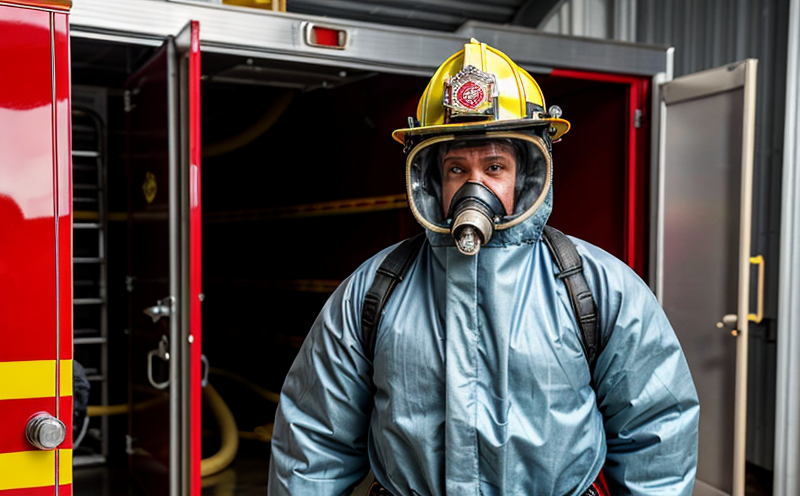NFPA 1951 Technical Rescue Protective Clothing Testing
The NFPA 1951 standard specifies requirements for protective clothing and equipment used by firefighters in technical rescue operations. This standard is crucial as it ensures that the gear worn by firefighters meets specific performance criteria to protect them from heat, flame, and other hazards encountered during complex rescue missions.
Firefighters engaged in technical rescue often face unique challenges. They work in confined spaces with limited visibility, where traditional firefighting tactics may not be effective or safe. The protective clothing they wear must withstand intense heat, provide thermal protection, and offer mobility to allow for efficient and safe rescues. NFPA 1951 addresses these specific requirements by setting stringent performance standards.
Testing under this standard involves a series of rigorous procedures designed to assess the physical properties and durability of technical rescue protective clothing. These tests ensure that the gear can withstand high temperatures, resist flame spread, maintain structural integrity, and provide adequate thermal insulation without compromising mobility.
The testing process typically begins with specimen preparation, where fabric samples are cut according to specified dimensions. The specimens undergo various tests aimed at evaluating their resistance to heat and flame, including:
- Thermal Insulation Test
- Flame Spread Test
- Mobility Assessment
- Water Resistance Test
In addition to these physical properties, the testing also evaluates the gear's ability to maintain its protective qualities after repeated use. This includes assessing the integrity of the fabric, the effectiveness of any flame retardants used, and the overall durability of the clothing.
The results of these tests are critical for ensuring that firefighters have reliable protection during technical rescue operations. Compliance with NFPA 1951 standards helps reduce the risk of injury or death by providing gear that is both effective and safe to use in challenging environments.
For quality managers, compliance officers, R&D engineers, and procurement specialists, understanding these testing procedures is essential for selecting appropriate protective clothing that meets the specific needs of technical rescue operations. By adhering to NFPA 1951 requirements, organizations can ensure they are providing their firefighters with the best possible protection.
Why It Matters
The importance of NFPA 1951 testing cannot be overstated in safeguarding firefighter safety during technical rescue operations. By ensuring that protective clothing meets stringent performance criteria, this standard plays a pivotal role in reducing the risk of injury or death.
In confined spaces and complex environments, firefighters often encounter extreme temperatures and hazardous materials that can severely burn unprotected skin. The NFPA 1951 testing process helps identify any weaknesses in the design or manufacturing of protective clothing, ensuring that the gear can effectively protect against these dangers.
Compliance with this standard also contributes to operational efficiency by allowing firefighters to focus on their primary mission—rescuing victims—without worrying about the safety of their protective equipment. This confidence in the gear's performance allows for quicker and more effective rescue operations, potentially saving lives.
For quality managers, compliance officers, R&D engineers, and procurement specialists, ensuring NFPA 1951 compliance is not just a regulatory requirement but a commitment to firefighter safety. By selecting protective clothing that meets these standards, organizations demonstrate their dedication to protecting the brave men and women who risk everything to save others.
The long-term benefits of adhering to this standard extend beyond immediate operational needs. Regular testing ensures continuous improvement in gear design, leading to safer and more effective equipment for future generations of firefighters. This proactive approach not only enhances current safety standards but also sets a precedent for innovation in protective clothing technology.
Applied Standards
NFPA 1951 is one of several standards that collectively define the requirements for protective clothing used by firefighters, including those involved in technical rescue operations. Some other relevant standards include:
- NFPA 1971: Standard on Protective Clothing and Equipment for Structural Firefighting.
- EN 468: Specification for Personal Protection Equipment (PPE) in the form of a full-body suit intended to provide protection against radiant heat.
- ASTM F1506: Standard Specification for Flame Resistant Protective Clothing for Fire Fighters.
These standards work together to create a comprehensive framework that ensures firefighters have access to the safest and most effective protective gear available. Each standard addresses specific aspects of firefighter safety, with NFPA 1951 focusing particularly on technical rescue operations where unique challenges require specialized equipment.
The adoption and implementation of these standards are crucial for maintaining high levels of fire safety across industries. By adhering to international best practices outlined in these documents, organizations can ensure that their protective clothing meets the highest standards of performance and safety.
Industry Applications
- Tactical Urban Operations: Firefighters involved in urban search and rescue missions often face confined spaces with limited visibility. Protective clothing tested to NFPA 1951 ensures that these firefighters can operate safely in such challenging environments.
- Catastrophic Events: In the aftermath of natural disasters or industrial accidents, firefighters may need to enter hazardous areas where traditional firefighting techniques are not applicable. The protection provided by NFPA 1951-compliant gear is essential for these critical rescue efforts.
- Confined Space Rescue: Firefighters often need to access tight spaces and navigate complex structures during technical rescue operations. Protective clothing that meets NFPA 1951 standards ensures they can perform these tasks safely without compromising their personal safety.
- Multi-Agency Operations: When multiple agencies are involved in a rescue operation, it is essential that all personnel use compatible protective gear. Compliance with NFPA 1951 helps ensure interoperability and coordination among different firefighting units.
The versatility of NFPA 1951-compliant protective clothing makes it an invaluable asset for firefighters working in diverse environments. By providing comprehensive protection against heat, flame, and other hazards, this gear enables firefighters to perform their critical duties safely and effectively.





